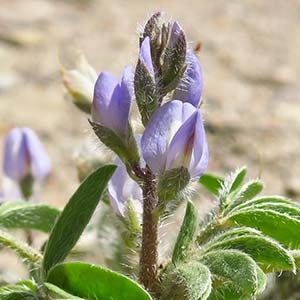Lupinus pusillus
Lupinus rivularis
intermountain lupine, low lupine, rusty lupine
river-bank lupine, stream bank lupine
short and tufted or erect, branched from base or near middle.
decumbent, ascending, or erect, branched, dark brown to red, usually hollow.
cauline, often crowded near base;
stipules well developed;
petiole 1–9 cm;
leaflets 5–9, blades 10–40 × 5–10 mm, adaxial surface glabrous.
cauline;
stipules 7–15 mm;
petiole 3–5 cm;
leaflets 5–9, blades 20–40 × 4–9 mm, adaxial surface glabrous.
8–12-flowered, 2–11 cm, shorter than or slightly exceeding foliage;
flowers spirally arranged.
open, 15–50 cm;
flowers ± whorled or not.
0–3.5 cm;
bracts persistent, straight, 2–5 mm.
3–15 cm;
bracts deciduous, 8–10 mm.
1–3.5 mm.
5–10 mm.
5–12 mm;
calyx abaxial lobe entire, 5–6 mm, adaxial lobe cleft, 2.5–4 mm;
corolla vivid blue, sometimes paler or white, sometimes bicolored, banner spot white or yellowish, keel glabrous.
12–16 mm;
calyx bulge or spur 0–1 mm, abaxial lobe entire or ± 3-toothed, 7–9 mm, adaxial lobe 2-toothed, 7–8 mm;
corolla violet, banner glabrous abaxially, lower keel margins glabrous, adaxial margin ciliate claw to tip.
1.5 cm, constricted between seeds, thinly pilose to coarsely hirsute.
dark, 3–7 cm, sparsely hairy.
persistent, disclike, sessile.
deciduous, petiolate.
2, wrinkled or ridged.
7 or 8, mottled brown with black line, 3–4 mm.
Lupinus pusillus
Lupinus rivularis
Varieties 3 (3 in the flora).
Lupinus pusillus is a highly variable species, with the varieties intergrading.
(Discussion copyrighted by Flora of North America; reprinted with permission.)
Lupinus rivularis ranges from Mendocino County in California northward through Oregon and Washington. It has been confirmed in British Columbia (where it is of conservation concern) in the extreme southwestern corner of the province, with a single population on southern Vancouver Island and five populations in the lower Fraser Valley.
Lupinus rivularis is distinguished by its absence of wood, banners that are glabrous abaxially, ciliate keels, glabrous leaf surfaces, and violet flowers. It grades into blue-flowered L. arboreus but blooms earlier (late winter, spring) and is not sweet-smelling. L. L. Phillips (1955) considered L. rivularis as synonymous with L. albicaulis.
Lupinus rivularis is widely planted for erosion control in western Oregon; it is of conservation concern in Canada.
(Discussion copyrighted by Flora of North America; reprinted with permission.)
1. Peduncles 0–1 cm; racemes shorter than foliage; flowers 6–8 mm. | var. intermontanus |
1. Peduncles usually 1–3.5 cm; racemes equal to or longer than foliage; flowers 7–12 mm. | → 2 |
2. Pedicels and calyx tubes strigose. | var. pusillus |
2. Pedicels and calyx tubes glabrous. | var. rubens |
- Local floras:
BC,
CA,
OR,
WA
- Local Web sites:
CalFlora,
CalPhotos,
Flora NW,
PNW Herbaria,
Turner Photog.
WildflowerSearch
iNaturalist (observations)
USDA Plants Database
- LBJ Wildflower Center
- SEINet
- Plants of the World Online
- Encyclopedia of Life
- Wikipedia
- Google Image Search
